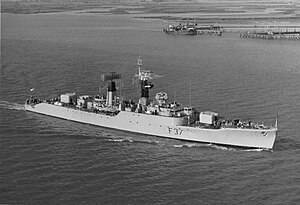Leopard class frigate
 |
|
| Class overview | |
|---|---|
| Operators: | |
| Built: | 1953–1960 |
| In commission: |
|
| Planned: | 5 British & 3 Indian |
| Completed: | 4 British & 3 Indian |
| Cancelled: | 1 British |
| Retired: | 7 |
| General characteristics | |
| Type: | Air Defence Frigate |
| Displacement: |
|
| Length: | 340 ft (100 m) o/a |
| Beam: | 40 ft (12 m) |
| Draught: | 16 ft (4.9 m) |
| Propulsion: |
|
| Speed: | 24 knots (28 mph; 44 km/h) |
| Range: | 7,500 nmi (13,900 km) at 16 kn (30 km/h) |
| Complement: | 205 or 235 |
| Sensors and processing systems: |
|
| Armament: |
|
The Type 41 or Leopard class were a class of anti-aircraft defence frigates built for the Royal Navy (4 ships) and Indian Navy (3 ships) in the 1950s.
These ships were designed to provide anti-aircraft escorts to convoys, as a result they were not built for fleet speeds and made only 24 knots (44 km/h). They shared a common hull and machinery with the Type 61 or Salisbury class aircraft direction vessels. An intended anti-submarine version, the Type 11 class (see Type system of the Royal Navy), was cancelled due to the low top speed being insufficient to combat contemporary adversaries, and was replaced by the turbine powered Type 12. Within a few years of the Type 41's introduction in the late 1950s they were regarded as obsolete for their intended function as anti aircraft convoy escorts, particularly after the failure of the power ramming for the twin 4.5 inch guns intended to boost the rate of fire from 14rpm to 24rpm, the abandonment of their STAAG, CIWS mount and replacement of the experimental version of the fast rotating 992 target indicators with the standard 993.
The Leopard class was also fitted with an early type of hydraulic stabiliser system consisting of two fins that could be extended outside the main hull to port and starboard, from a compartment between the two engine rooms. Gyro controlled with a relatively simple control system, they proved very effective in use. During testing every 3 months at sea, the ship could be easily driven into a 20°+ roll from the manual control on the bridge. Prior warning had to be given to allow stowage of loose items over the ship's tannoy system before testing was carried out. Slight reduction in top speed was also noticed when in use.
They were used mainly as pure patrol frigates, notably on the South American station operating out of Simonstown in South Africa, and on Cod War duties. In 1972 it was decided not to refit HMS Puma again, as purchasing the half sister of the class, the former Black Star ordered by Ghana, and commissioning it as HMS Mermaid, would cost less than a Type 41 refit. HMS Leopard finished its service in the 1975-6 cod war, having given an Icelandic gunboat a 30-second warning that it would open fire with its 4.5 guns. HMS Lynx was the last of the class operational in 1977, attending the Spithead 1977 fleet review. HMS Jaguar was reactivated, from the standby squadron for the 3rd Cod War, but sprang too many leaks on the voyage to Iceland and sailed back to Chatham in the UK.
...
Wikipedia
